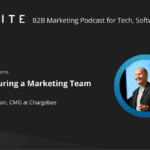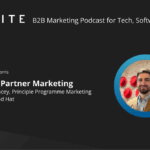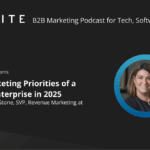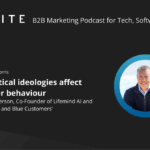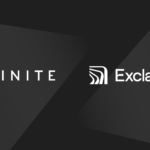James Stacey is our new FINITE Ambassador! He’s an expert in demand generation within enterprise-sized B2B tech organisations, having worked with Red Hat for the past two years as Team Lead on the Global Commercial Performance Team.
James successfully incorporates data, marketing tools and technologies into Red Hat’s programme activities to hit key global objectives – impressive stuff!
We interviewed James to learn about his favourite area of B2B marketing, and where he sees this going next.
Watch the full interview or read the transcript below!
Hi James, thanks for joining us. To kick off the interview, could you please share about your background in marketing and your current role?
I’ve been a member of FINITE now for about a year now, and I’ve been in the Slack channel, and love the discussions, the questions and I love how everyone looks after one another.
Like many marketers, I moved into the field from another profession, so I started as an analyst in the music industry, and then after a few jumps and leaps I now work for RedHat at an enterprise level. It’s a software company, and I focus on demand gen. I’ve been there for two years and love it.
Thanks for the FINITE shoutout! What’s your favourite area of B2B tech marketing currently and why?
I think my favourite area of tech marketing has been the evolution of the marketing journey. We’re stepping away from lead-based marketing. You can call it ABM, but any KPIs that are account-based, and measuring how engaged a particular account is with your marketing efforts, is something I’m finding really interesting.
Lots of different companies are doing it in different ways, but ultimately what it’s going to lead to is better marketing to people who are hearing your message. So I think that’s probably where I place my bets.
Digging deeper, what are the most common challenges you see B2B tech marketers facing this area at the moment?
There are always lots of different moving parts when it comes to marketing, and we’re growing at different speeds in those areas. What I’m seeing more and more is we’re very good at collecting data, we’re very good at storing data, whether that be first-party, third-party.
But what we’re not very good at is – and I speak generally of course – is really utilising that data and delivering campaigns and segmenting effectively and running omnichannel, with all of the data and making messaging effective.
I think we’ve got to a point now where we’re collecting the data really well, and there’s some great tools out there to help orchestrate, but the thing I think we’re challenged with is utilising all that data when it comes to campaigns.
And looking forward, where do you see this area of B2B tech marketing headed next?
If I stay on the same point around utilising the data, I think it all comes down to orchestration. We’ve got multiple products, whether that’s the storage of data, sales, marketing, running campaigns through the channel…
Essentially, the better we orchestrate, and I don’t want to name-drop too many tools, but Adobe’s got a great suite that’s interconnected, all of their products speak to one another, and gets you to deliver that omnichannel experience that means your customers will receive consistency wherever they go.
I think orchestration is where we’re going to see some really exciting movement in the coming years.
What’s your favourite tool at the moment?
Given I’ve just name-dropped them, I probably would say the Adobe engagement platform. So obviously it’s a suite of tools, you’ve got a portfolio of different marketing products and other sales and CRMs and all sorts.
But essentially, having all of that information and capabilities in one place is really helping us grow our marketing and make it consistent. So Adobe would be my tip of the week.
Finally, tell us a fun fact about yourself
I grew up on a farm and spent my formative years looking after sheep, cattle and tractors. I still go back and it’s rewarding to see tangible results from the hard work which goes into the farm.


